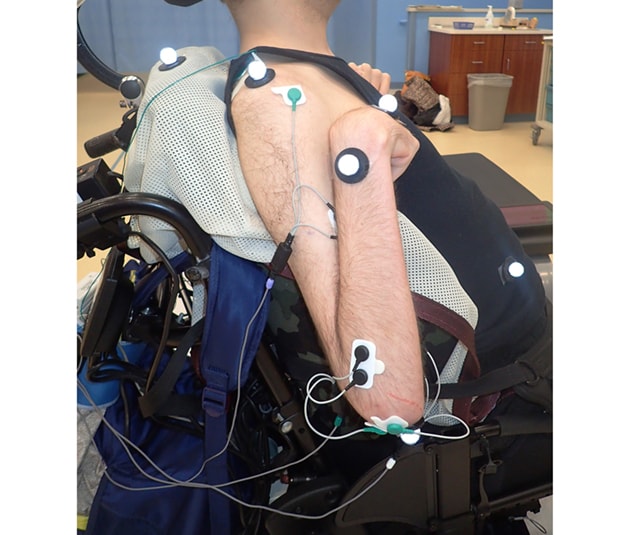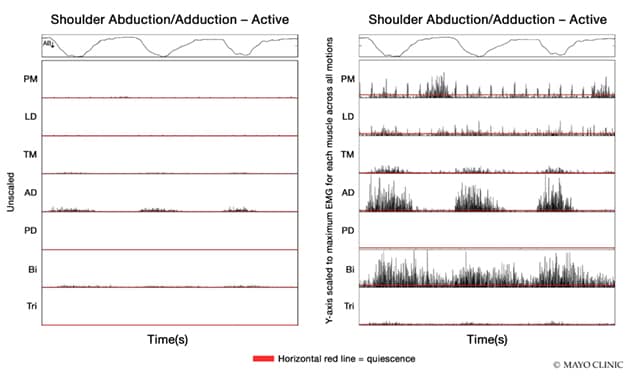Sept. 24, 2019
Mayo Clinic's unique use of dynamic electromyography (EMG) with motion analysis helps provide sophisticated care for people with upper motor neuron syndrome. Comprehensive evaluations performed in the Motion Analysis Laboratory at Mayo Clinic in Rochester, Minnesota, provide insight into which muscles are viable for transfer, aiding Mayo Clinic orthopedic surgeons in their efforts to restore upper-body function and decrease patients' pain.
"In our lab, we assess patients while they perform specific movements related to activities of daily living. Motion capture and data analysis help us to identify muscles that could be moved to augment a function that the patient is missing," says Kenton R. Kaufman, Ph.D., the laboratory's director.
The testing is ordered by Mayo Clinic orthopedic surgeons for patients who might benefit from surgical treatment of upper motor neuron syndromes. Patients with spinal cord injuries, traumatic or anoxic brain injuries, or brain injuries due to stroke or cerebral palsy might be candidates for this preoperative testing.
"Dynamic testing is invaluable because for many patients, using clinical exams alone makes it very difficult to get an accurate assessment of the muscles that are viable," says Peter C. Rhee, D.O., a hand surgeon at Mayo Clinic in Rochester, Minnesota. "The results of dynamic EMG not only can confirm what we believe is happening with a muscle but also can sometimes give us new information that directly influences the surgical plan — details that otherwise might have led to a poor surgical outcome."
The Motion Analysis Laboratory began performing pre-surgical testing for upper motor neuron syndrome in late 2018. The testing generally takes about four hours. As well as detecting functional muscles, dynamic functional assessment can identify pathologic motor groups that are causing spastic deformities.
"This truly is precision medicine, because it analyzes an individual's muscles to help us determine what we can do to give that person optimal function. Every patient is unique," Dr. Kaufman says.
Animation techniques with enhanced software
A patient prepares for EMG with motion analysis

A patient prepares for EMG with motion analysis
A patient prepares for dynamic electromyography (EMG) with motion analysis in Mayo Clinic's Motion Analysis Laboratory.
Mayo Clinic's dynamic EMG uses motion-capture technology similar to that used in animated motion pictures, although with more-sophisticated analytical software. Before testing starts, about a dozen reflective markers are attached to the patient's upper body.
"Most of the muscles we want to record cannot be accessed by surface EMG. They require deep, fine-wire electrodes for recording," says Krista A. Coleman Wood, Ph.D., P.T., who performs the lab's dynamic testing. "Patients might feel the needle prick when we insert the wire, but there is no pain when they are asked to perform various tasks."
Measurements of muscle activation

Measurements of muscle activation
Measurements of muscle activation are analyzed to help determine which muscles might be candidates for surgical transfer.
Guided by Dr. Coleman Wood, patients attempt various upper-body movements. Ten infrared cameras in the laboratory capture the motion and measure muscle activation. Each four-hour test requires several hours of data analysis.
"We go through every movement to determine if each muscle we tested is doing what it should be doing, interfering with the patient's movement or just not doing anything," says Kathie A. Bernhardt, a biomechanical engineer in the Motion Analysis Laboratory. "If a muscle is firing inappropriately, we can identify if it's a spastic muscle or just a muscle that's on all the time."
Testing can also identify muscles that aren't yet candidates for transfer but might be if the patient succeeds in obtaining greater control over them through techniques such as biofeedback. "We have instrumentation on a scale that gives us the precision we need to visualize even small-amplitude muscle activity," Dr. Coleman Wood says.
The underlying techniques used by the Motion Analysis Laboratory were developed decades ago by the late Jacquelin Perry, M.D., with whom Dr. Kaufman previously worked. Technological advances have facilitated the adoption of dynamic EMG for research. The clinical application of these techniques requires close collaboration between laboratory scientists and physicians.
"This service can be performed only in a center where a dynamic EMG motion lab works closely with surgeons, and where scientists and clinicians meet regularly to discuss patients and guide their treatment," Dr. Rhee says.
"Patients with upper motor neuron syndrome have very complex issues that require precise testing and a high level of surgical talent," Dr. Kaufman adds. "Mayo Clinic devotes the time and effort needed to provide the best care we can for these patients."
For more information
Motion Analysis Laboratory. Mayo Clinic.